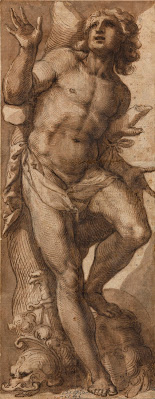 |
| Sisto Badalocchio St John the Evangelist ca. 1610-30 oil on canvas Galleria Estense, Modena |
 |
| Sisto Badalocchio Tancred baptizing Clorinda (scene from Gerusalemme Liberata of Torquato Tasso) ca. 1609-10 oil on canvas Galleria Estense, Modena |
 |
| Sisto Badalocchio Virgin and Child ca. 1603-1605 oil on canvas Pinacoteca Capitolina, Rome |
 |
| Sisto Badalocchio St John baptizing the People in the River Jordan ca. 1617-21 oil on canvas Galleria Estense, Modena |
 |
| Sisto Badalocchio Gods of the Four Elements ca. 1605 ceiling fresco Sala di Giove, Palazzo Bentivoglio, Bologna |
 |
| Sisto Badalocchio Ganymede receives the Chalice of Immortality ca. 1605 ceiling fresco Sala di Giove, Palazzo Bentivoglio, Bologna |
 |
| Sisto Badalocchio Scene of Combat from the Roman History of Titus Livius ca. 1605 frieze fresco Sala di Giove, Palazzo Bentivoglio, Bologna |
 |
| Sisto Badalocchio Scene with Romulus and Remus from the Roman History of Titus Livius ca. 1605 frieze fresco Sala di Giove, Palazzo Bentivoglio, Bologna |
 |
| Sisto Badalocchio Holy Women at the Sepulchre ca. 1620 drawing Metropolitan Museum of Art, New York |
 |
| attributed to Sisto Badalocchio Apollo and Marsyas ca. 1615-20 drawing Teylers Museum, Haarlem |
 |
| Sisto Badalocchio St Sebastian before 1647 drawing Royal Collection, Windsor |
 |
| attributed to Sisto Badalocchio Sketches for St Sebastian and a River God ca. 1620 drawing Musée du Louvre |
 |
| attributed to Sisto Badalocchio Nude Figures enacting a Scene of Violence ca. 1620 drawing Musée du Louvre |
 |
| attributed to Sisto Badalocchio Baptism of Christ ca. 1620 drawing Musée du Louvre |
 |
| attributed to Sisto Badalocchio Study of the Head of a Youth before 1647 drawing Royal Collection, Windsor |
In Art and Architecture in Italy, 1600-1750, Rudolf Wittkower describes a generation of young artists emerging from the Carracci academy in Bologna at the beginning of the seventeenth century, a cohort that included Sisto Badalocchio –
"I have already indicated that the Carracci school presents a picture vastly different from the Caravaggisti. A phalanx of young Bolognese artists, observing Annibale's success, chose to follow him to Rome; nor did events show that their assessment of the situation was incorrect. They had besides much to recommend themselves. First and foremost they were excellent artists. They had undergone a thorough training in the Carracci academy and had acquired a solid classical background even before they reached Rome. They were supported by Annibale's unrivalled authority and could rely on a circle of wealthy and powerful patrons. Moreover, they were all masters of the fresco technique and were, therefore, both able to assist Annibale in his own work and to execute monumental fresco commissions on their own account. In addition, during the short reign of Gregory XV (1621-3), who was himself born in Bologna, they were in undisputed command of the situation."